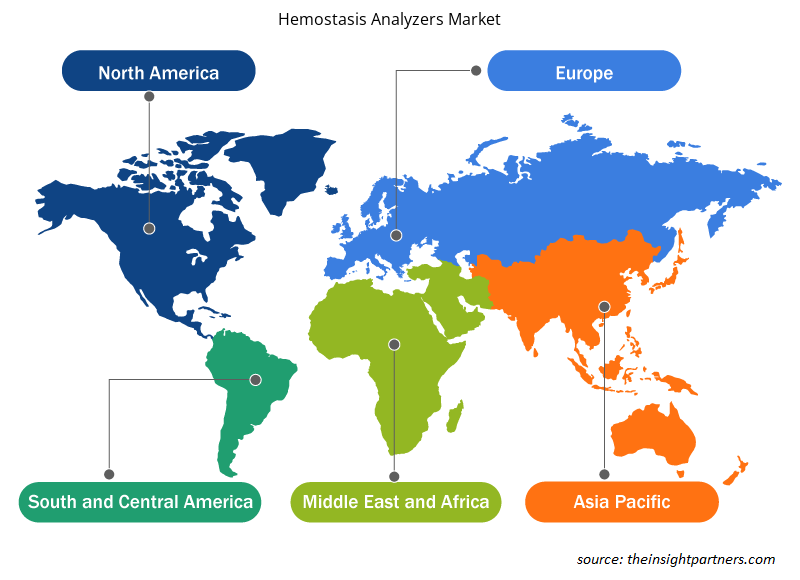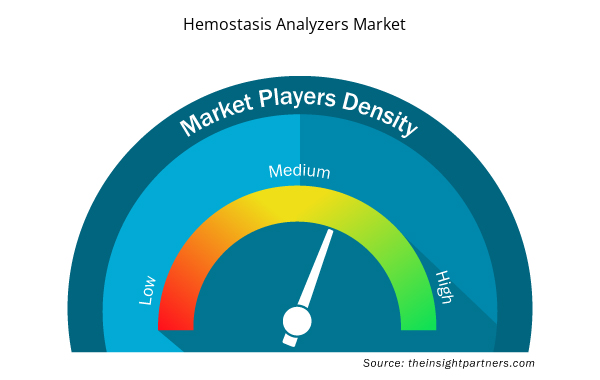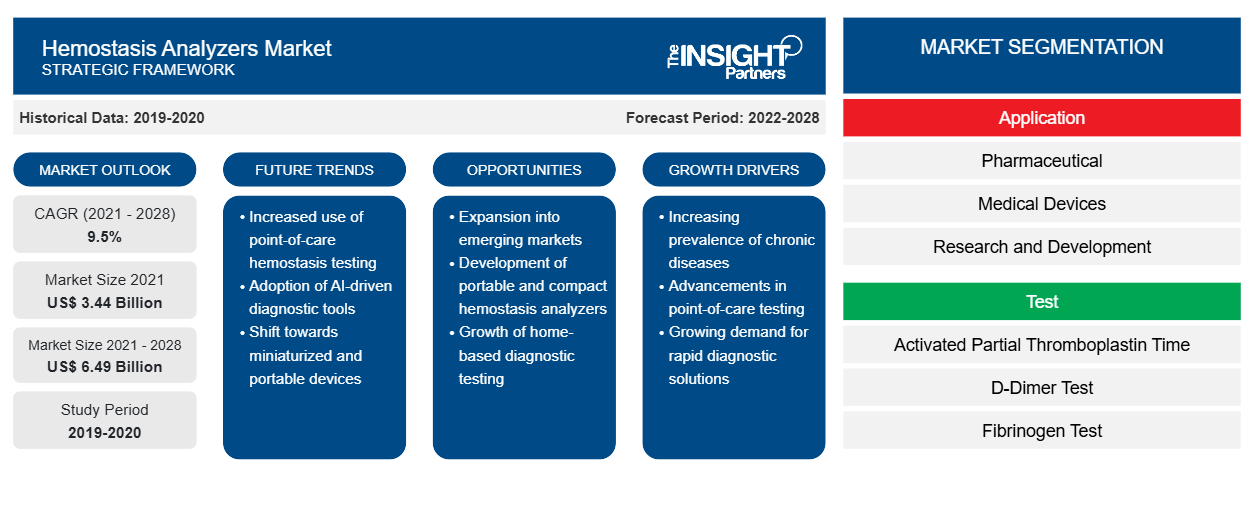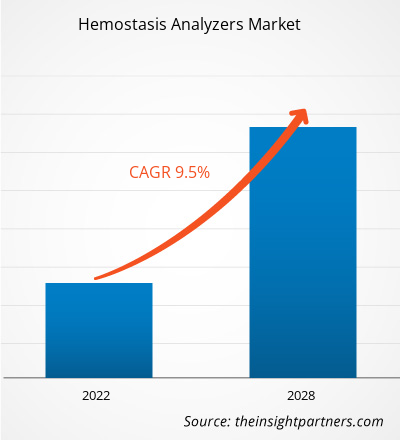Si prevede che il mercato degli analizzatori dell'emostasi raggiungerà i 6.490,24 milioni di dollari entro il 2028, rispetto ai 3.440,66 milioni di dollari del 2021; si prevede che registrerà un CAGR del 9,5% dal 2021 al 2028.
Gli analizzatori di emostasi forniscono una misurazione rapida e semplice dei livelli di piastrine nel sangue. Un test di coagulazione potrebbe aiutare a rilevare e prevenire i coaguli di sangue che potrebbero causare un infarto. Un analizzatore di coagulazione può misurare la velocità del percorso di coagulazione e le quantità di trombolina e tromboplastina in meno di pochi minuti. Le malattie cardiovascolari (CVD) probabilmente rimarranno la causa più significativa di morbilità e mortalità in tutto il mondo. Le CVD sono disturbi del cuore e dei vasi sanguigni e includono malattie cerebrovascolari, malattie coronariche, malattie cardiache reumatiche e altre condizioni. Alcuni problemi correlati allo stile di vita che portano a malattie cardiovascolari e difficoltà sono l'uso di tabacco, una dieta non sana e l'inattività fisica. Aumentano il rischio di infarti e ictus. Altri fattori di rischio per le malattie cardiovascolari sono l'ipertensione, il diabete e l'aumento dei livelli di colesterolo. Secondo l'Organizzazione mondiale della sanità (OMS), le malattie cardiovascolari sono la prima causa di morte a livello globale.
Personalizza questo report in base alle tue esigenze
Riceverai la personalizzazione gratuita di qualsiasi report, comprese parti di questo report, o analisi a livello nazionale, pacchetto dati Excel, oltre a usufruire di grandi offerte e sconti per start-up e università
- Scopri le principali tendenze di mercato in questo rapporto.Questo campione GRATUITO includerà analisi di dati che spaziano dalle tendenze di mercato alle stime e alle previsioni.
Market Insights
L'aumento della popolazione geriatrica guiderà il mercato degli analizzatori di emostasi
Le persone anziane sono inclini alle malattie cardiache a causa della debole immunità e di altri problemi di salute. I fattori generali dell'invecchiamento portano all'irrigidimento del cuore e dei vasi sanguigni che provocano disturbi cardiaci. Con l'avanzare dell'età, aumenta anche la pressione sanguigna sistolica, portando a malattie cardiovascolari (CVD). Pertanto, nelle persone di età pari o superiore a 75 anni, l'ipertensione è un fattore di rischio comune per le malattie cardiache. La malattia coronarica e l'insufficienza cardiaca sono gli altri. Sebbene l'incidenza delle aritmie comprenda persone di tutte le fasce d'età, sta aumentando in modo significativo tra la popolazione geriatrica. Secondo il sondaggio Global Ageing 2019, la popolazione mondiale di 65 anni e oltre ha totalizzato 703 milioni nel 2019. Si prevede che la fascia demografica degli anziani raddoppierà fino a raggiungere 1,5 miliardi di persone entro il 2050. La frequenza di una persona di 65 anni o più aumenterà probabilmente da 1 su 11 abitanti nel 2019 a 1 su 6 abitanti entro il 2025. Questa fascia demografica è più suscettibile alle malattie cardiovascolari, come le aritmie. Analogamente, secondo l'Organizzazione mondiale della sanità (OMS), si stima che la percentuale di persone di età pari o superiore a 60 anni raggiungerà il 22% entro il 2050 dal 12% nel 2015. Secondo il rapporto "Older Americans 2016: Key Indicators of Well-Being" del Federal Interagency Forum on Aging-Related Statistics, il 35,8% degli individui di età pari o superiore a 85 anni ha avuto un disturbo cognitivo lieve o estremo. Inoltre, secondo il rapporto delle Nazioni Unite sull'invecchiamento della popolazione mondiale del 2017, nel 2017, 962 milioni di persone avevano 60 anni o più in tutto il mondo e si prevede che il numero raggiungerà quasi 2,1 miliardi entro il 2050. La popolazione anziana è più incline a presentazioni atipiche, condizioni comorbide e risultati sfavorevoli. La ragione principale delle malattie è correlata ai cambiamenti strutturali e funzionali nel sistema cardiovascolare associati all'invecchiamento. L'aumento della popolazione geriatrica globale sta portando a un'impennata delle malattie cardiovascolari, che, a sua volta, sta spingendo la domanda di analizzatori di emostasiCVDs). Thus, in people aged 75 years and above, high blood pressure is a common risk factor for heart conditions. Coronary artery disease and heart failure are the others. Although the incidence of arrhythmias encompasses people of all age groups, it is rising significantly among the geriatric population.
Ageing 2019 survey, the world's population of 65 years and above totaled 703 million in 2019. The senior demographic is expected to double to 1.5 billion people by 2050. The frequency of one person with age 65 or more is likely to increase from 1 in every 11 inhabitants in 2019 to 1 in every 6 inhabitants by 2025. This demographic is more susceptible to CVDs, such as arrhythmias. Similarly, according to the World Health Organization (WHO), the percentage of people aged 60 and above is estimated to reach 22% by 2050 from 12% in 2015. As per the report "Older Americans 2016: Key Indicators of Well-Being" by the Federal Interagency Forum on Aging-Related Statistics, 35.8% of individuals aged 85 and above had a mild or extreme cognitive disorder. Moreover, according to the United Nation's World Population Ageing 2017 report, in 2017, 962 million people were aged 60 years or over worldwide, and the number is expected to reach nearly 2.1 billion by 2050.
comorbid conditions, and unfavorable outcomes. The primary reason for the diseases is related to the structural and functional changes in the cardiovascular system associated with aging. The rise in the global geriatric population is leading to a surge in cardiovascular diseases, which, in turn, is propelling the demand for hemostasis analyzers
Informazioni basate sul tipo di prodotto
In base al tipo di prodotto, il mercato degli analizzatori di emostasi analyzers market è ulteriormente segmentato in analizzatori di laboratorio e sistemi di test point-of-care . Nel 2021, il segmento degli analizzatori di laboratorio detiene la quota maggiore del mercato e si stima che il segmento dei sistemi di test point-of-care registrerà il CAGR più elevato nel periodo 2021-2028.CAGR during 2021–2028.
Quota di mercato degli analizzatori di emostasi, per tipo di prodotto – 2021 e 2028
Approfondimenti basati sui test
In base ai test, il mercato è segmentato in tempo di tromboplastina parziale attivata, test del D-dimero, test del fibrinogeno, test del tempo di protrombina e altri. Nel 2021, il segmento del tempo di tromboplastina parziale attivata ha detenuto la quota maggiore del mercato. Si prevede che il segmento del test del tempo di protrombina registrerà il CAGR più elevato nel mercato durante il periodo 2021-2028.
Informazioni basate sull'utente finale
Based on end users, the market is segmented into hospitals/clinics, independent diagnostic laboratories, home care settings, and others. In 2021, the hospitals/clinics segment accounted for the largest share of the market. The independent diagnostic laboratories segment is expected to register the highest CAGR in the market during 2021–2028.
Companies operating in the hemostasis analyzers market emphasize adopting the strategy of product innovations to meet the evolving customer demands worldwide, which also permits them to maintain their brand name in the global market.
Hemostasis Analyzers Market – Segmentation
The Hemostasis Analyzers market is segmented based on product type, test, and end-user. Based on product type, the hemostasis analyzers market is segmented into laboratory analyzers and point-of-care testing systems. Based on test, the market is further segmented into activated partial thromboplastin time, D-Dimer test, fibrinogen test, prothrombin time test, and others. Based on end-user, the market is segmented into hospitals/clinics, independent diagnostic laboratories, home care settings, and others. In terms of geography, the hemostasis analyzers market is segmented into North America (the US, Canada, and Mexico), Europe (France, Germany, Italy, the UK, Spain, and the Rest of Europe), Asia Pacific (Australia, China, India, Japan, South Korea, and the Rest of APAC), the Middle East & Africa (Saudi Arabia, South Africa, the UAE, and the Rest of MEA), and South and Central America (Brazil, Argentina, and the Rest of SCAM)
Hemostasis Analyzers Market Regional Insights
The regional trends and factors influencing the Hemostasis Analyzers Market throughout the forecast period have been thoroughly explained by the analysts at Insight Partners. This section also discusses Hemostasis Analyzers Market segments and geography across North America, Europe, Asia Pacific, Middle East and Africa, and South and Central America.

- Get the Regional Specific Data for Hemostasis Analyzers Market
Hemostasis Analyzers Market Report Scope
| Report Attribute | Details |
|---|---|
| Market size in 2021 | US$ 3.44 Billion |
| Market Size by 2028 | US$ 6.49 Billion |
| Global CAGR (2021 - 2028) | 9.5% |
| Historical Data | 2019-2020 |
| Forecast period | 2022-2028 |
| Segments Covered | By Application
|
| Regions and Countries Covered | North America
|
| Market leaders and key company profiles |
|
Densità degli attori del mercato: comprendere il suo impatto sulle dinamiche aziendali
Il mercato degli analizzatori emostatici sta crescendo rapidamente, spinto dalla crescente domanda degli utenti finali dovuta a fattori quali l'evoluzione delle preferenze dei consumatori, i progressi tecnologici e una maggiore consapevolezza dei vantaggi del prodotto. Con l'aumento della domanda, le aziende stanno ampliando le loro offerte, innovando per soddisfare le esigenze dei consumatori e capitalizzando sulle tendenze emergenti, il che alimenta ulteriormente la crescita del mercato.
La densità degli operatori di mercato si riferisce alla distribuzione di aziende o società che operano in un particolare mercato o settore. Indica quanti concorrenti (operatori di mercato) sono presenti in un dato spazio di mercato in relazione alle sue dimensioni o al valore di mercato totale.
Le principali aziende che operano nel mercato degli analizzatori dell'emostasi sono:
- Siemens AG
- Laboratorio di strumentazione
- Abate
- Società per azioni
- Società Nihon Kohden
Disclaimer : le aziende elencate sopra non sono classificate secondo un ordine particolare.

- Ottieni una panoramica dei principali attori del mercato degli analizzatori dell'emostasi
Profili aziendali
- Siemens AG
- Laboratorio di strumentazione
- Abate
- Società per azioni
- Società Nihon Kohden
- Thermo Fisher Scientific Inc.
- Diagnostica Roche
- Diagnostica Stago
- Laboratori Helena
- Società internazionale Technidyne.
- Analisi storica (2 anni), anno base, previsione (7 anni) con CAGR
- Analisi PEST e SWOT
- Valore/volume delle dimensioni del mercato - Globale, regionale, nazionale
- Industria e panorama competitivo
- Set di dati Excel



Report Coverage
Revenue forecast, Company Analysis, Industry landscape, Growth factors, and Trends

Segment Covered
This text is related
to segments covered.

Regional Scope
North America, Europe, Asia Pacific, Middle East & Africa, South & Central America

Country Scope
This text is related
to country scope.
Domande frequenti
The Asia Pacific is expected to be the fastest-growing region and is likely to expand at a high growth rate due to the rising development in the pharmaceutical sector. Also, the rise in the incidence of cardiovascular diseases is likely to provide more significant growth opportunities to the market players in the coming years is likely to boost the growth of the market in the Asia Pacific region.
The global hemostasis analyzers market based on product is segmented into product type [laboratory analyzer (automated systems, semi-automated systems, and manual systems) and point-of-care testing systems. In 2021, the laboratory analyzer segment held the largest share of the market by product and point-of-care testing systems is expected to witness the fastest CAGR during 2021 to 2028.
The global hemostasis analyzers market is segmented into North America, Europe, Asia Pacific, Middle East & Africa, and South & Central America. In the North America region, the market for hemostasis analyzers market is primarily held by the US among the other countries. The growth of the hemostasis analyzers market in the United States is expected to grow owing to increasing organic developments by the market players in the market, rising awareness among consumers for treatment, and an increase in the prevalence of chronic illnesses like blood disorders and cardiovascular diseases.
The hemostasis analyzers market majorly consists of the players such as Siemens AG, Instrumentation Laboratory, Abbott, Sysmex Corporation, Nihon Kohden Corporation, Thermo Fisher Scientific Inc., Roche Diagnostics, Diagnostica Stago, Helena Laboratories, International Technidyne Corporation are amongst others.
Hemostasis analyzers are medical devices that are used to measure the clotting time of hemostasis to detect clotting deficiencies and facilitate the treatment of patients with an excess bleeding condition by medical practitioners.
The factors driving and restraining the hemostasis analyzers market in the coming years include the high prevalence of cardiovascular diseases and the rise in the geriatric population. However, the high cost of a fully automated hemostasis analyzer is likely to hamper the market's growth.
Trends and growth analysis reports related to Life Sciences : READ MORE..
The List of Companies - Hemostasis Analyzers Market
- Siemens AG
- Instrumentation Laboratory
- Abbott
- Sysmex Corporation
- Nihon Kohden Corporation
- Thermo Fisher Scientific Inc.
- Roche Diagnostics
- Diagnostica Stago
- Helena Laboratories
- International Technidyne Corporation
The Insight Partners performs research in 4 major stages: Data Collection & Secondary Research, Primary Research, Data Analysis and Data Triangulation & Final Review.
- Data Collection and Secondary Research:
As a market research and consulting firm operating from a decade, we have published and advised several client across the globe. First step for any study will start with an assessment of currently available data and insights from existing reports. Further, historical and current market information is collected from Investor Presentations, Annual Reports, SEC Filings, etc., and other information related to company’s performance and market positioning are gathered from Paid Databases (Factiva, Hoovers, and Reuters) and various other publications available in public domain.
Several associations trade associates, technical forums, institutes, societies and organization are accessed to gain technical as well as market related insights through their publications such as research papers, blogs and press releases related to the studies are referred to get cues about the market. Further, white papers, journals, magazines, and other news articles published in last 3 years are scrutinized and analyzed to understand the current market trends.
- Primary Research:
The primarily interview analysis comprise of data obtained from industry participants interview and answers to survey questions gathered by in-house primary team.
For primary research, interviews are conducted with industry experts/CEOs/Marketing Managers/VPs/Subject Matter Experts from both demand and supply side to get a 360-degree view of the market. The primary team conducts several interviews based on the complexity of the markets to understand the various market trends and dynamics which makes research more credible and precise.
A typical research interview fulfils the following functions:
- Provides first-hand information on the market size, market trends, growth trends, competitive landscape, and outlook
- Validates and strengthens in-house secondary research findings
- Develops the analysis team’s expertise and market understanding
Primary research involves email interactions and telephone interviews for each market, category, segment, and sub-segment across geographies. The participants who typically take part in such a process include, but are not limited to:
- Industry participants: VPs, business development managers, market intelligence managers and national sales managers
- Outside experts: Valuation experts, research analysts and key opinion leaders specializing in the electronics and semiconductor industry.
Below is the breakup of our primary respondents by company, designation, and region:

Once we receive the confirmation from primary research sources or primary respondents, we finalize the base year market estimation and forecast the data as per the macroeconomic and microeconomic factors assessed during data collection.
- Data Analysis:
Once data is validated through both secondary as well as primary respondents, we finalize the market estimations by hypothesis formulation and factor analysis at regional and country level.
- Macro-Economic Factor Analysis:
We analyse macroeconomic indicators such the gross domestic product (GDP), increase in the demand for goods and services across industries, technological advancement, regional economic growth, governmental policies, the influence of COVID-19, PEST analysis, and other aspects. This analysis aids in setting benchmarks for various nations/regions and approximating market splits. Additionally, the general trend of the aforementioned components aid in determining the market's development possibilities.
- Country Level Data:
Various factors that are especially aligned to the country are taken into account to determine the market size for a certain area and country, including the presence of vendors, such as headquarters and offices, the country's GDP, demand patterns, and industry growth. To comprehend the market dynamics for the nation, a number of growth variables, inhibitors, application areas, and current market trends are researched. The aforementioned elements aid in determining the country's overall market's growth potential.
- Company Profile:
The “Table of Contents” is formulated by listing and analyzing more than 25 - 30 companies operating in the market ecosystem across geographies. However, we profile only 10 companies as a standard practice in our syndicate reports. These 10 companies comprise leading, emerging, and regional players. Nonetheless, our analysis is not restricted to the 10 listed companies, we also analyze other companies present in the market to develop a holistic view and understand the prevailing trends. The “Company Profiles” section in the report covers key facts, business description, products & services, financial information, SWOT analysis, and key developments. The financial information presented is extracted from the annual reports and official documents of the publicly listed companies. Upon collecting the information for the sections of respective companies, we verify them via various primary sources and then compile the data in respective company profiles. The company level information helps us in deriving the base number as well as in forecasting the market size.
- Developing Base Number:
Aggregation of sales statistics (2020-2022) and macro-economic factor, and other secondary and primary research insights are utilized to arrive at base number and related market shares for 2022. The data gaps are identified in this step and relevant market data is analyzed, collected from paid primary interviews or databases. On finalizing the base year market size, forecasts are developed on the basis of macro-economic, industry and market growth factors and company level analysis.
- Data Triangulation and Final Review:
The market findings and base year market size calculations are validated from supply as well as demand side. Demand side validations are based on macro-economic factor analysis and benchmarks for respective regions and countries. In case of supply side validations, revenues of major companies are estimated (in case not available) based on industry benchmark, approximate number of employees, product portfolio, and primary interviews revenues are gathered. Further revenue from target product/service segment is assessed to avoid overshooting of market statistics. In case of heavy deviations between supply and demand side values, all thes steps are repeated to achieve synchronization.
We follow an iterative model, wherein we share our research findings with Subject Matter Experts (SME’s) and Key Opinion Leaders (KOLs) until consensus view of the market is not formulated – this model negates any drastic deviation in the opinions of experts. Only validated and universally acceptable research findings are quoted in our reports.
We have important check points that we use to validate our research findings – which we call – data triangulation, where we validate the information, we generate from secondary sources with primary interviews and then we re-validate with our internal data bases and Subject matter experts. This comprehensive model enables us to deliver high quality, reliable data in shortest possible time.


 Ottieni un campione gratuito per questo repot
Ottieni un campione gratuito per questo repot